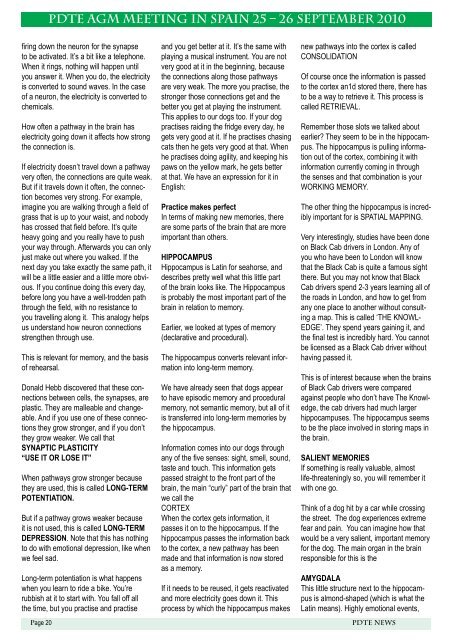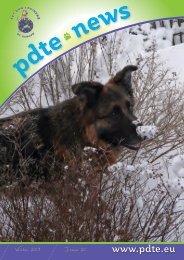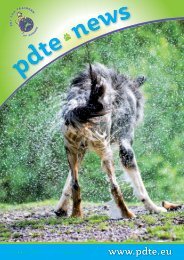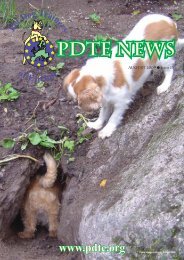PDTE 2011 July Newsletter
Create successful ePaper yourself
Turn your PDF publications into a flip-book with our unique Google optimized e-Paper software.
<strong>PDTE</strong> AGM MEETING In SPAIN 25 – 26 September 2010<br />
firing down the neuron for the synapse<br />
to be activated. It’s a bit like a telephone.<br />
When it rings, nothing will happen until<br />
you answer it. When you do, the electricity<br />
is converted to sound waves. In the case<br />
of a neuron, the electricity is converted to<br />
chemicals.<br />
How often a pathway in the brain has<br />
electricity going down it affects how strong<br />
the connection is.<br />
If electricity doesn’t travel down a pathway<br />
very often, the connections are quite weak.<br />
But if it travels down it often, the connection<br />
becomes very strong. For example,<br />
imagine you are walking through a field of<br />
grass that is up to your waist, and nobody<br />
has crossed that field before. It’s quite<br />
heavy going and you really have to push<br />
your way through. Afterwards you can only<br />
just make out where you walked. If the<br />
next day you take exactly the same path, it<br />
will be a little easier and a little more obvious.<br />
If you continue doing this every day,<br />
before long you have a well-trodden path<br />
through the field, with no resistance to<br />
you travelling along it. This analogy helps<br />
us understand how neuron connections<br />
strengthen through use.<br />
This is relevant for memory, and the basis<br />
of rehearsal.<br />
Donald Hebb discovered that these connections<br />
between cells, the synapses, are<br />
plastic. They are malleable and changeable.<br />
And if you use one of these connections<br />
they grow stronger, and if you don’t<br />
they grow weaker. We call that<br />
SYNAPTIC PLASTICITY<br />
“USE IT OR LOSE IT”<br />
When pathways grow stronger because<br />
they are used, this is called LONG-TERM<br />
POTENTIATION.<br />
But if a pathway grows weaker because<br />
it is not used, this is called LONG-TERM<br />
DEPRESSION. Note that this has nothing<br />
to do with emotional depression, like when<br />
we feel sad.<br />
Long-term potentiation is what happens<br />
when you learn to ride a bike. You’re<br />
rubbish at it to start with. You fall off all<br />
the time, but you practise and practise<br />
Page 20<br />
and you get better at it. It’s the same with<br />
playing a musical instrument. You are not<br />
very good at it in the beginning, because<br />
the connections along those pathways<br />
are very weak. The more you practise, the<br />
stronger those connections get and the<br />
better you get at playing the instrument.<br />
This applies to our dogs too. If your dog<br />
practises raiding the fridge every day, he<br />
gets very good at it. If he practises chasing<br />
cats then he gets very good at that. When<br />
he practises doing agility, and keeping his<br />
paws on the yellow mark, he gets better<br />
at that. We have an expression for it in<br />
English:<br />
Practice makes perfect<br />
In terms of making new memories, there<br />
are some parts of the brain that are more<br />
important than others.<br />
HIPPOCAMPUS<br />
Hippocampus is Latin for seahorse, and<br />
describes pretty well what this little part<br />
of the brain looks like. The Hippocampus<br />
is probably the most important part of the<br />
brain in relation to memory.<br />
Earlier, we looked at types of memory<br />
(declarative and procedural).<br />
The hippocampus converts relevant information<br />
into long-term memory.<br />
We have already seen that dogs appear<br />
to have episodic memory and procedural<br />
memory, not semantic memory, but all of it<br />
is transferred into long-term memories by<br />
the hippocampus.<br />
Information comes into our dogs through<br />
any of the five senses: sight, smell, sound,<br />
taste and touch. This information gets<br />
passed straight to the front part of the<br />
brain, the main “curly” part of the brain that<br />
we call the<br />
CORTEX<br />
When the cortex gets information, it<br />
passes it on to the hippocampus. If the<br />
hippocampus passes the information back<br />
to the cortex, a new pathway has been<br />
made and that information is now stored<br />
as a memory.<br />
If it needs to be reused, it gets reactivated<br />
and more electricity goes down it. This<br />
process by which the hippocampus makes<br />
new pathways into the cortex is called<br />
CONSOLIDATION<br />
Of course once the information is passed<br />
to the cortex an1d stored there, there has<br />
to be a way to retrieve it. This process is<br />
called RETRIEVAL.<br />
Remember those slots we talked about<br />
earlier? They seem to be in the hippocampus.<br />
The hippocampus is pulling information<br />
out of the cortex, combining it with<br />
information currently coming in through<br />
the senses and that combination is your<br />
WORKING MEMORY.<br />
The other thing the hippocampus is incredibly<br />
important for is SPATIAL MAPPING.<br />
Very interestingly, studies have been done<br />
on Black Cab drivers in London. Any of<br />
you who have been to London will know<br />
that the Black Cab is quite a famous sight<br />
there. But you may not know that Black<br />
Cab drivers spend 2-3 years learning all of<br />
the roads in London, and how to get from<br />
any one place to another without consulting<br />
a map. This is called ‘THE KNOWL-<br />
EDGE’. They spend years gaining it, and<br />
the final test is incredibly hard. You cannot<br />
be licensed as a Black Cab driver without<br />
having passed it.<br />
This is of interest because when the brains<br />
of Black Cab drivers were compared<br />
against people who don’t have The Knowledge,<br />
the cab drivers had much larger<br />
hippocampuses. The hippocampus seems<br />
to be the place involved in storing maps in<br />
the brain.<br />
SALIENT MEMORIES<br />
If something is really valuable, almost<br />
life-threateningly so, you will remember it<br />
with one go.<br />
Think of a dog hit by a car while crossing<br />
the street. The dog experiences extreme<br />
fear and pain. You can imagine how that<br />
would be a very salient, important memory<br />
for the dog. The main organ in the brain<br />
responsible for this is the<br />
AMYGDALA<br />
This little structure next to the hippocampus<br />
is almond-shaped (which is what the<br />
Latin means). Highly emotional events,<br />
<strong>PDTE</strong> NEWS

















